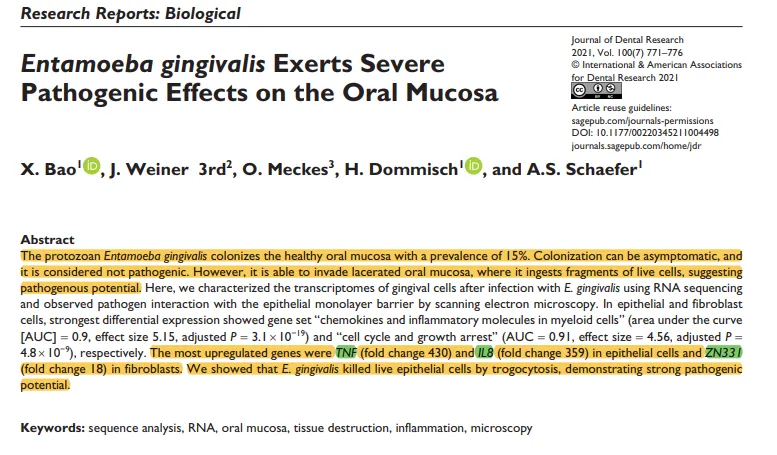Blog

Entamoeba gingivalis Exerts Severe Pathogenic Effects on the Oral Mucosa
Entamoeba gingivalis Exerts Severe Pathogenic Effects on the Oral Mucosa
X. Bao1 , J. Weiner 3rd2, O. Meckes3, H. Dommisch1 , and A.S. Schaefer
Abstract
The protozoan Entamoeba gingivalis colonizes the healthy oral mucosa with a prevalence of 15%. Colonization can be asymptomatic, and it is considered not pathogenic. However, it is able to invade lacerated oral mucosa, where it ingests fragments of live cells, suggesting pathogenous potential. Here, we characterized the transcriptomes of gingival cells after infection with E. gingivalis using RNA sequencing and observed pathogen interaction with the epithelial monolayer barrier by scanning electron microscopy. In epithelial and fibroblast cells, strongest differential expression showed gene set “chemokines and inflammatory molecules in myeloid cells” (area under the curve [AUC] = 0.9, effect size 5.15, adjusted P = 3.1×10−19) and “cell cycle and growth arrest” (AUC = 0.91, effect size = 4.56, adjusted P = 4.8×10−9), respectively. The most upregulated genes were TNF (fold change 430) and IL8 (fold change 359) in epithelial cells and ZN331 (fold change 18) in fibroblasts. We showed that E. gingivalis killed live epithelial cells by trogocytosis, demonstrating strong pathogenic potential.
Keywords: sequence analysis, RNA, oral mucosa, tissue destruction, inflammation, microscopy.
Contact Us
+61 404 039 649
